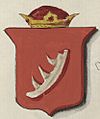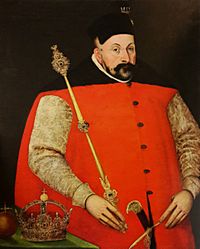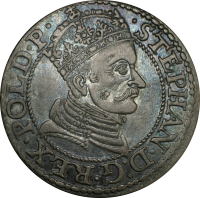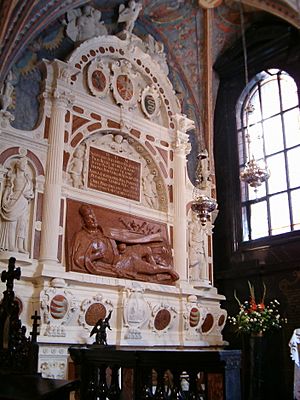Stephen Báthory facts for kids
Quick facts for kids Stephen Báthory |
|
|---|---|
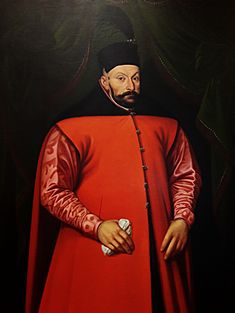
A 19th-century copy of a portrait attributed to Martin Kober representing Stephen Báthory in decorative Sarmatian attire
|
|
| King of Poland Grand Duke of Lithuania (jure uxoris) |
|
| Reign | 1 May 1576 – 12 December 1586 |
| Coronation | 1 May 1576 Wawel Cathedral |
| Predecessor | Henry of Valois |
| Successor | Sigismund III |
| Co-monarch | Anna Jagiellon |
| Prince of Transylvania | |
| Reign | 1576–1586 |
| Predecessor | John Sigismund Zápolya |
| Successor | Sigismund Báthory |
| Born | 27 September 1533 Szilágysomlyó, Eastern Hungarian Kingdom |
| Died | 12 December 1586 (aged 53) Grodno, Polish–Lithuanian Commonwealth |
| Burial | May 1588 Wawel Cathedral, Kraków |
| Spouse | |
| House | Báthory |
| Father | Stephen Báthory of Somlyó |
| Mother | Catherine Telegdi |
| Religion | Roman Catholicism |
| Signature | |
Stephen Báthory (born September 27, 1533 – died December 12, 1586) was an important ruler in Eastern Europe. He was the Voivode of Transylvania (1571–1576), then the Prince of Transylvania (1576–1586). He also became the King of Poland and Grand Duke of Lithuania (1576–1586).
Stephen Báthory was part of the Hungarian Báthory noble family. He became a powerful leader in Transylvania in the 1570s. In 1576, he married Queen Anna Jagiellon and became the third elected king of Poland. He worked closely with his chancellor, Jan Zamoyski.
His first years as king were about gaining full control. He had to defeat other people who wanted the throne, like Maximilian II, Holy Roman Emperor. He also stopped rebellions, especially one in Danzig. He ruled for only ten years. However, he is seen as one of the most successful kings in Polish history, especially because of his military skills. His biggest achievement was winning a war in Livonia against Russia. He pushed back a Russian invasion and made a very good peace treaty called the Peace of Jam Zapolski.
Contents
Early Life and Rise to Power
Stephen Báthory was born on September 27, 1533. He was born in a castle in Somlyó, which is now called Șimleu Silvaniei. His father was Stephen VIII Báthory, and his mother was Catherine Telegdi. He had several brothers and sisters.
We don't know much about his childhood. Around 1549, he visited Italy. He likely studied for a few months at the University of Padua. When he returned, he joined the army of Ferdinand I, Holy Roman Emperor. He fought against the Turks.
Later, Báthory was captured by the Turks. When Ferdinand I refused to pay for his release, Báthory joined the other side. He supported John II Sigismund Zápolya in his fight for power in the Eastern Hungarian Kingdom. Báthory served Zápolya as a military leader and a diplomat. He was even held under house arrest in Vienna for two years.
After Zápolya died in 1571, the nobles in Transylvania chose Báthory as their Voivode of Transylvania. Another noble, Gáspár Bekes, disagreed with this choice. Bekes was supported by the Habsburg family. But Báthory won the civil war by 1573 and forced Bekes out of Transylvania. After this, Báthory tried to play the Ottomans and the Holy Roman Empire against each other. This helped him make Transylvania stronger.
Becoming King of Poland
In 1572, the throne of the Polish-Lithuanian Commonwealth became empty. The previous king, Sigismund II Augustus, died without children. The Polish parliament, called the Sejm, had the power to choose a new king. In 1573, they chose Henry III of France. However, Henry soon became king of France and left Poland.
Stephen Báthory decided to try for the Polish throne. Before that, he had to defeat Gáspár Bekes again in Transylvania. He won the Battle of Kerelőszentpál.
On December 12, 1575, some Polish leaders chose Maximilian II, Holy Roman Emperor as the new king. But others, led by chancellor Jan Zamoyski, wanted a Polish king. They decided that Anna Jagiellon, the sister of the last king, should be queen. They also decided she should marry Stephen Báthory.
In January 1576, Báthory gave his title as Voivode of Transylvania to his brother, Christopher Báthory. Then he traveled to Poland. On May 1, 1576, Stephen Báthory married Anna. He was crowned king of Poland and grand duke of Lithuania. After becoming king, he also used the title of prince of Transylvania.
Securing His Rule
At first, Stephen Báthory's position was very difficult. Some people still opposed him. Emperor Maximilian still claimed the throne and was ready to fight for it. Also, the leaders of Lithuania did not want to recognize Báthory as their Grand Duke. They asked for special promises from him. He agreed to their terms, and by June, Lithuania accepted him.
The city of Gdańsk (Danzig) also refused to accept Báthory as king. This rich city, supported by Maximilian, had chosen the Emperor. This led to a conflict known as the Danzig rebellion. Báthory's forces began a long siege of the city. On April 17, 1577, Báthory's army defeated the Danzig army in a battle. However, his forces could not capture the city itself.
So, they reached a compromise. Danzig recognized Báthory as the ruler of Poland. In return, the city paid him a large sum of money. In February 1578, he also confirmed George Frederick as the ruler of the Duchy of Prussia. This helped Báthory secure the northern parts of the Commonwealth.
King Stephen's Policies
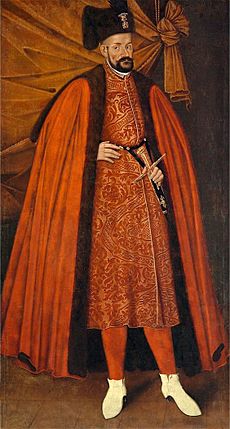
After gaining control, Báthory focused on making his rule stronger. His chancellor, Jan Zamoyski, was a very trusted advisor. Báthory improved the legal system by creating new courts. These were the Crown Tribunal (1578) and the Lithuanian Tribunal (1581).
The Sejm allowed him to raise taxes. This helped him make reforms to strengthen the military. He created a new infantry unit made of peasants called the piechota wybraniecka. He also wanted to modernize the army, making it more like the Hungarian troops from Transylvania.
Báthory also founded the Academy of Vilnius. This was the third university in the Commonwealth. He also started several other Jesuit colleges. He supported Catholicism. However, he also respected the Commonwealth's policy of religious tolerance. He issued rules to protect Polish Jews and spoke out against any religious violence.
In foreign relations, Báthory wanted peace through strong alliances. He did not fully trust the Habsburgs. But he kept good relations with the Holy Roman Empire. He also made truces with the Ottoman Empire in 1577 and 1579. In January 1578, the Sejm agreed to give Báthory money for a war against Muscovy.
Many of his trusted advisors were Hungarian. He was always interested in Hungarian politics. In his last years, Báthory planned to free Ottoman Hungary with a Christian army, mostly Polish. He wanted to create a strong union between Hungary and Poland under his rule. But the international situation made it hard for him to achieve these plans. Besides Hungarian, he spoke Latin, Italian, and German. He never learned Polish.
In his private life, he was known for being careful with money. His favorite hobbies were hunting and reading.
War with Muscovy
Before Báthory became king, Ivan the Terrible of Russia started taking over lands in the northeast, in Livonia. This conflict grew to involve many countries, including Russia, Poland-Lithuania, Sweden, and Denmark-Norway. Everyone wanted control of Livonia. This long conflict became known as the Livonian War.
By 1577, Ivan controlled most of the disputed land. But his control did not last long. In 1578, the Commonwealth forces won several battles in Livonia. They began pushing Ivan's forces back. This was a turning point in the war. Báthory and his chancellor Zamoyski led the Commonwealth army. They won major victories, taking Polotsk in 1579 and Velikiye Luki in 1580.
In 1581, Stephen entered Russia again. On August 22, he began the Siege of Pskov. The city held out, but on December 13, 1581, Ivan the Terrible started peace talks. These talks led to the Truce of Jam Zapolski on January 15, 1582. This treaty was very good for the Commonwealth. Ivan gave up Polotsk, Velizh, and most of Duchy of Livonia. In return, he got back Velikiye Luki and Nevel.
Final Years and Legacy
In 1584, Báthory allowed Zamoyski to execute Samuel Zborowski. Zborowski had been sentenced to death for treason and murder years earlier. This event caused a big political conflict between Báthory and the Zborowski family. Many saw it as a clash between the king and the nobility's rights.
Báthory's health had been getting worse for several years. He died on December 12, 1586. He did not have any children. After his death, there was a period of one year without a king. Maximilian II's son, Archduke Maximilian III, was chosen as king. But the Swedish Sigismund III Vasa challenged him. Sigismund defeated Maximilian and became the ruler of the Commonwealth.
How Stephen Báthory Is Remembered
Báthory actively promoted his own story. He supported many works about his life and achievements, including historical writings and poems. During his lifetime, writers like Jan Kochanowski wrote about him. He became a common character in Polish literature and poetry. Many later writers, like Józef Ignacy Kraszewski, featured him in their works. He was also the subject of many paintings, both during his life and after. Famous painters like Jan Matejko painted him.
A statue of Báthory was put up in 1789 in Padua, Italy. It was paid for by the last king of the Commonwealth, Stanisław August Poniatowski. Other monuments to him include one in the Łazienki Palace and one in Sniatyn. He was also the patron of the Vilnius University. Several units in the Polish Army were named after him from 1919 to 1939. Two 20th-century passenger ships of the Polish Merchant Navy were named after him: the MS Batory and TSS Stefan Batory. In modern Poland, the Batory Steelmill and the Stefan Batory Foundation are named after him. Many Polish streets and schools also carry his name. One district of the town of Chorzów is named Chorzów Batory.
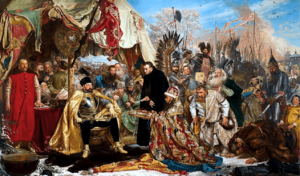
Right after his death, he was not remembered very fondly in the Commonwealth. Many nobles thought his actions, especially in the Zborowski affair, showed he wanted to limit their "Golden Freedoms" and become an absolute monarchy. People also disliked that he favored Hungarians over people from the Commonwealth. He was also remembered for his Hungarian-style cap and saber.
Later, in the 19th century, when Poland lost its independence, his image improved. He was remembered for his military wins and praised as a strong ruler by many historians. In 1887, a historian noted that Báthory was "the darling of both the Polish public opinion and Polish historians." Between the World Wars, he was seen as a hero in Poland. He was often compared to the leader of Poland at the time, Józef Piłsudski. After World War II, in communist Poland, he became a more debated figure. Historians started to question his internal policies and his strong connection to Hungary. Still, his good image largely remained, helped by positive views from popular historians like Paweł Jasienica.
See also
 In Spanish: Esteban I Báthory para niños
In Spanish: Esteban I Báthory para niños
- History of Poland (1569–1795)
- Muscovite wars
- Nyírbátor


